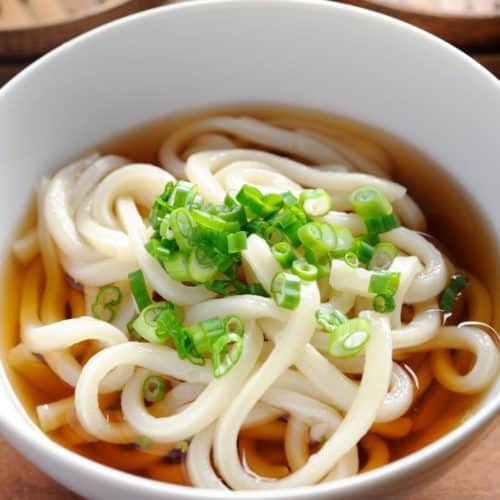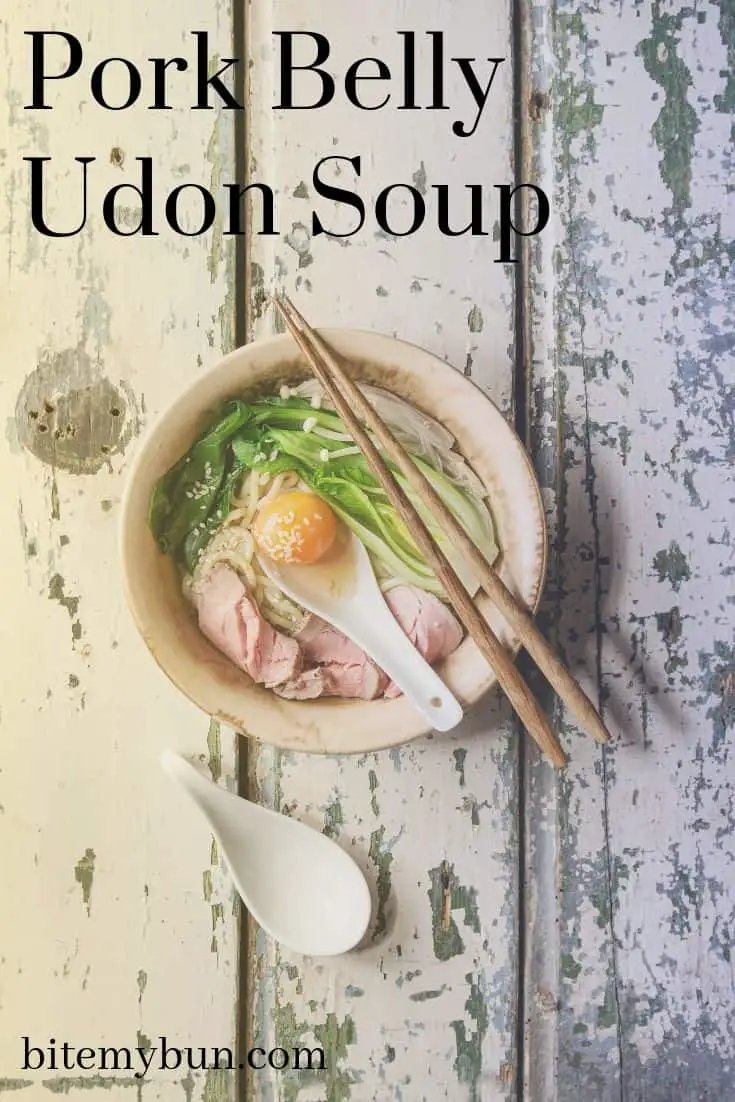Pork Belly Udon Soup Recipe: Juice and Delicious
If you’re craving udon soup but don’t what to put in it today, this pork belly version is for you!
The juices of the pork flow so nicely together with the dashi broth that you just want to dig in, so let’s start making it!

Check out our new cookbook
Bitemybun's family recipes with complete meal planner and recipe guide.
Try it out for free with Kindle Unlimited:
Read for freeIn this post we'll cover:
How to make pork belly udon soup

Pork Belly Udon Soup
Ingredients
Pork Belly
- 2 spring onions
- 7 oz pork belly
- 2 cloves garlic thinly sliced
- 1 thumb ginger grated
- ½ cup soy sauce
- ½ cup mirin
- ¼ cup sake
- 1 tbsp sugar
Dashi stock
- 3 inch kombu piece
- 4 cups water
- 3 cups katsuobushi bonito flakes
Udon Soup
- 1 packet udon noodles (7 oz.)
- 1 egg
- 2 tbsp soy sauce
- 2 tbsp mirin
- 2 tsp sugar
- 1¼ tsp salt
- 1 tbsp sake
- 1 bunch bok choy or pak choy (chopped into 2 inch pieces)
- ½ cup bean sprouts
- 1 sheet nori cut into 4 squares
- 2 spring onions
Instructions
- Chop off both of the ends of the spring onions (about 10cm in length), then cut them into an allumette, set them in a pan and add cold water to it. Reserve for later use (garnish).
- Chop what’s left of the spring onions into thin rounded slices.
- Put the saucepan on top of the stove, fill it with water and out the pork belly in. Turn on the heat and set to high, then bring to a boil. Simmer for 10 minutes.
- Remove the scum that floats on the water surface with a skimmer. Turn off the stove and remove the pork belly. Rinse with running water and then use paper towels to pat them dry.
- Replace the water in the saucepan with a clean one and boil the pork belly in it once more for another 30 minutes. Remove and rinse the pork once more and then pat dry with paper towels again as you did before. This time cut the pork belly into thick slices.
- Rinse the saucepan and make it ready for another round of cooking. Pour the sake, mirin and the soy sauce into the saucepan, then toss the spring onion, ginger and garlic as well.
- This time add the pork into the saucepan along with the other ingredients and simmer it until much of the liquid has evaporated leaving only a sticky sauce that makes the pork cuts look glossy. Turn off the stove and set the pork mix aside for later use.
- Now for making dashi stock. First, wipe down the kombu with a wet towel, then make a few slices along the length of the kombu at around 2 to 3 cm intervals).
- Get a new clean saucepan, pour water in it and place the kombu in the water, then bring to boil. After 2-3 minutes turn off the stove and remove the kombu and place it in a clean plate.
- Boil the bonito flakes in water too! Do this for about 30 seconds, turn off the stove and then wait for the bonito flakes to sink to the bottom of the pot (This should take about 10 minutes).
- Get a fine sieve strain (you may want to place paper towels over it to filter the liquid further) and pour the liquid from the bonito flakes that you’ve boiled earlier, then extract all the liquid.
- Boil the udon noodles for about 8-10 minutes until it becomes firm to the bite. Drain the hot water and rinse the noodles in cold running water.
- Divide the udon equally between 2 large serving bowls.
- Boil some water in a small pot. Use an egg piercer or a small pin to pierce the base of the egg and place it in the water. Stir regularly and cook for 6 and 1/2 minutes.
- Turn off the stove and remove the egg from the pot, then place it in a small bowl filled with cold water. Peel off the shell and then cut the egg in half, then set aside for later use.
- This time boil the Dashi stock in a large saucepan, reduce heat to simmer and add the mirin, soy sauce, sugar, sake, and salt.
- Stir the mix and sample the broth if it has the right taste (add a few more ingredients for seasoning if necessary). Simmer for a few more minutes in low heat.
- Next is to add the bok choy to the Dashi mix and simmer them for an additional 5 minutes.
- Pour the Dashi broth in each bowl of udon noodles. Decorate the udon with the sliced half boiled eggs, add some bean sprouts, spring onion allumette, and nori on the top, then serve.
Though it may seem similar to ramen, udon is a very different kind of noodle-based dish. The noodles are generally thicker and different ingredients are used when making it.
One of the few ways that the two dishes are similar is that they both use dashi as the stock.
After all, since dashi works well in ramen and miso soup it makes sense that it would go great in a bowl of udon.
I’ve got this post on how to use Udon noodles and make A LOT of delicious noodle dishes.

Cooking tips
If you’re using frozen udon noodles, be sure to thaw them before cooking. The dried ones in a packet work best here, be sure to get a quality brand because that makes all the difference.
The udon noodles are so thick that you’ll taste a lot of it while eating, so a mouthful of below par noodles will ruin the dish.
To cook the pork belly, we recommend boiling or simmering it until tender. You can also fry it, but be careful not to overcook it and make it tough.
When adding the soup ingredients to the pot, be sure to taste as you go. The amount of mirin, soy sauce, ginger, and dashi will vary depending on the brand you use, and add the bok choy last so it remains crunchy.
We like to top our udon soup with a soft-boiled egg, but feel free to add whatever toppings you like. shredded nori, green onions, and radishes all work well here.
Substitutes
Dashi substitute
The soup stock needs dashi, that’s a given. But we have a vegan shiitake and kombu dashi variant that you could make.
Mirin substitute
If you don’t have any mirin, just add a little extra sake of the same amount and 1 extra teaspoon of sugar.
How to serve and eat
The best way to eat udon is with chopsticks. Use your left hand to hold the bowl close to your mouth and use your right hand to pick up the noodles.
If you’re having trouble using chopsticks, you could always use a fork.
To slurp or not to slurp? That is the question. Slurping is actually considered polite in Japan when eating noodles, so we say go for it! It also helps to cool the noodles down and makes them easier to eat.
If you’re not used to eating with chopsticks, don’t worry, just do your best. Eating with chopsticks is a skill that takes practice, but it’s not the end of the world if you can’t master it. Just enjoy your soup!
Udon noodle soups are typically eaten as a main dish, but they can also be eaten as a side dish or appetizer. They’re perfect for winter because they’re warm and comforting, but they can be enjoyed all year round.
Similar dishes
If you like udon soup, you might also like these similar dishes:
Ramen – a Japanese noodle soup that’s typically made with wheat noodles and a meat or fish-based broth.
Soba – Japanese buckwheat noodles that are often served cold with a dipping sauce or in a broth.
Pho – a Vietnamese soup that’s typically made with rice noodles and a beef or chicken broth.
Wonton soup – a Chinese soup that’s made with wontons (dumplings) in a clear broth.
What to drink with udon soup
Udon soup goes well with a variety of drinks, but we think it pairs best with:
Sake – a Japanese rice wine that’s typically served chilled.
Green tea – a light, refreshing tea that’s perfect for sipping between bites.
Beer – because beer goes with everything, right?
Conclusion
We hope you enjoyed our pork belly udon soup recipe! Udon soup is a delicious, hearty dish that’s perfect for a winter meal. But it can be enjoyed all year round. So what are you waiting for? Give it a try!
Check out our new cookbook
Bitemybun's family recipes with complete meal planner and recipe guide.
Try it out for free with Kindle Unlimited:
Read for freeJoost Nusselder, the founder of Bite My Bun is a content marketer, dad and loves trying out new food with Japanese food at the heart of his passion, and together with his team he's been creating in-depth blog articles since 2016 to help loyal readers with recipes and cooking tips.
